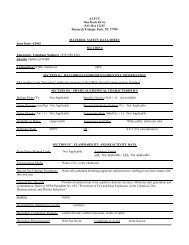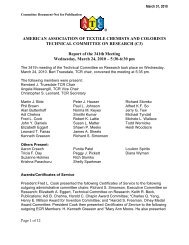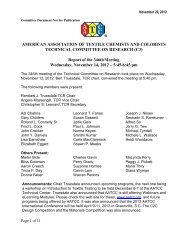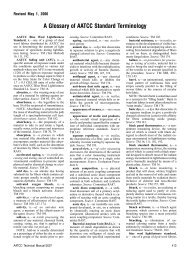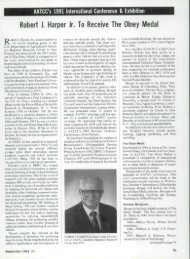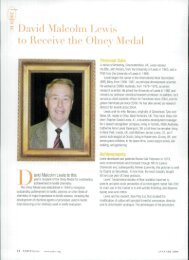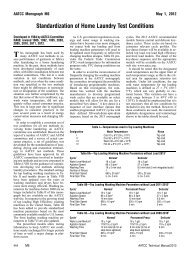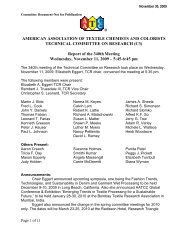A Glossary of AATCC Standard Terminology - AATCC. American ...
A Glossary of AATCC Standard Terminology - AATCC. American ...
A Glossary of AATCC Standard Terminology - AATCC. American ...
Create successful ePaper yourself
Turn your PDF publications into a flip-book with our unique Google optimized e-Paper software.
emoval <strong>of</strong> soil or stains in a local area.<br />
(see also prespotting.) Source: Committee<br />
RA93 and TM 157.<br />
spreading speed, (SS i), n.—the accumulated<br />
rate <strong>of</strong> surface wetting from the<br />
center <strong>of</strong> the specimen where the test solution<br />
is dropped to the maximum wetted<br />
radius. Source: TM 195.<br />
stability, n.—<strong>of</strong> dye dispersions, the resistance<br />
to chemical decomposition, physical<br />
disintegration, agglomeration or any<br />
combination <strong>of</strong> these. Source: TM 166.<br />
stain, n.—a local deposit <strong>of</strong> soil or discoloration<br />
on a substrate that exhibits some<br />
degree <strong>of</strong> resistance to removal, as by laundering<br />
or drycleaning. Source: TM 130.<br />
stain, n.—for pile floor covering, a<br />
discoloration due to a color adding material,<br />
such as food or liquid, that exhibits<br />
resistance to removal by standard cleaning<br />
methods. Source: TM 175.<br />
stainblocker, n.—a chemical substance<br />
which, when applied to a textile<br />
substrate, imparts partial or total resistance<br />
to staining. Source: TM 175.<br />
standard atmosphere for testing textiles,<br />
n.—air maintained at 21 ± 1C (70 ±<br />
2F) and 65 ± 2% relative humidity.<br />
Source: TM 111, 169, 186, 192.<br />
standard depth scale, n.—in color<br />
measurement, a series <strong>of</strong> dyed samples <strong>of</strong><br />
different hue and chroma that have been<br />
accepted to have the same depth. Source:<br />
Evaluation Procedure 4.<br />
standardization, n.—<strong>of</strong> color measuring<br />
instrument, the act <strong>of</strong> measuring one<br />
or more standard materials with a color<br />
measuring instrument for the purpose <strong>of</strong><br />
calculating a set <strong>of</strong> correction factors to<br />
be applied to all subsequent measurements.<br />
Source: Evaluation Procedure 6.<br />
start time, n.—the time at which the<br />
water challenge is added to the specimen.<br />
Source: TM 201.<br />
steam cleaning, n.—see the correct<br />
term, hot water extraction. Source: TM<br />
171.<br />
steaming, n.—in textile dyeing or<br />
printing, treatment with moist steam to<br />
promote penetration and/or fixation <strong>of</strong><br />
the dye.<br />
NOTE: The steam may be neutral,<br />
acid, or air-free depending on the dye<br />
class. Source: Committee RA93.<br />
stone-washed, adj.—in garment processing,<br />
a descriptive term denoting alteration<br />
<strong>of</strong> the appearance <strong>of</strong> a new garment<br />
to give it a worn or laundered appearance.<br />
SYN: washdown. Source: Committee<br />
RA93.<br />
substrate, n.—in textiles, a fiber, fiber<br />
assembly, yarn, fabric or film to which<br />
another material is applied. Source: Committee<br />
RA93.<br />
sulfur dye, n.—a dye, containing sulfur<br />
both as an integral part <strong>of</strong> the chromophore<br />
and in attached polysulfide<br />
chains, normally applied in the alkali-soluble<br />
reduced (leuco) form from a sodium<br />
sulfide solution and subsequently oxidized<br />
to the insoluble form in the fiber.<br />
Source: Committee RA87, TM 26.<br />
surface active agent, n.—see surfactant.<br />
Source: Committee RA93.<br />
surfactant, n.—a soluble or dispersible<br />
material which reduces the surface<br />
tension <strong>of</strong> a liquid, usually water. Source:<br />
Committee RA93.<br />
tearing strength, n.—the average<br />
force required to continue a tear previously<br />
started in a fabric. Source: TM 111,<br />
169, 192.<br />
test side, n.—the side, either the face<br />
or back <strong>of</strong> a specimen, which is uppermost<br />
when placed on the moisture balance<br />
analyzer support platform; the side<br />
onto which the test volume <strong>of</strong> water is applied.<br />
Source: TM 199.<br />
textile floor covering, n.—an article<br />
having a use-surface composed <strong>of</strong> textile<br />
material and generally used for covering<br />
floors. Source: TM 121, 122, 123, 138,<br />
165, 171.<br />
textile product, n.—an article <strong>of</strong> fabric,<br />
or other flexible material, made to<br />
protect or decorate the body (garments),<br />
for use in the home (bedding, drapery,<br />
towels, table linens), or other uses (i.e<br />
handkerchiefs, etc.). Source: TM 79.<br />
thermal finishing, n.—the process <strong>of</strong><br />
applying heat to textiles to impart desired<br />
functional and/or aesthetic characteristics.<br />
NOTE: Thermal finishing includes<br />
heat setting, hot embossing, etc. but excludes<br />
drying. Source: Committee RA93.<br />
thermal fixation, n.—the use <strong>of</strong> dry<br />
heat to achieve a degree <strong>of</strong> permanence<br />
when applying colorants to textile materials.<br />
Source: TM 154.<br />
tinctorial strength, n.—the effectiveness<br />
<strong>of</strong> a given mass <strong>of</strong> dye in coloring a<br />
given mass <strong>of</strong> material. Source: Evaluation<br />
Procedure 4.<br />
tint, n.—a colorant, applied to a substrate<br />
for purposes <strong>of</strong> identification,<br />
which is easily removed from the substrate<br />
by subsequent wet treatment.<br />
Source: Committee RA93.<br />
tint, n.—in whiteness measurement,<br />
the hue <strong>of</strong> a white material as influenced<br />
by the wavelength <strong>of</strong> peak emission or reflectance<br />
(CIE 15.2). Source: TM 110.<br />
total irradiance, n.—radiant power integrated<br />
over all wavelengths at a point in<br />
time expressed in watts per square meter<br />
(W/m 2 ). Source: TM 16.1, 16.2, 16.3,<br />
169.<br />
tolerance range specimens, n.—<br />
selected specimens which deviate from<br />
the reference standard in hue, lightness,<br />
chroma, or in combinations <strong>of</strong> the three,<br />
and impose a range <strong>of</strong> observable color<br />
differences around the reference standard<br />
for evaluation purposes. Source:<br />
Evaluation Procedure 9.<br />
top surface – (t), n.—for testing purposes,<br />
the side <strong>of</strong> a specimen that, when<br />
the specimen is placed on the lower elec-<br />
trical sensor, is facing the upper sensor.<br />
This is the side <strong>of</strong> the fabric that would<br />
come in contact with the skin when a garment<br />
is worn or when a product is used.<br />
Source: TM 195.<br />
total water content – (U) (%), n.—<br />
the sum <strong>of</strong> the percent water content <strong>of</strong><br />
the top and bottom surfaces.<br />
NOTE: Total water content measurements<br />
may be more accurately termed,<br />
“total surface water content,” particularly<br />
in the case <strong>of</strong> fabric with cellulosic content.<br />
Total water content implies that all<br />
water in the specimen is being measured<br />
which may be the case with some manufactured<br />
fabrics. However, when testing<br />
cellulosic fibers, moisture trapped in the<br />
interior <strong>of</strong> the fiber (for example, in the<br />
lumen <strong>of</strong> cotton fibers) will not be included<br />
with a specimen’s detected surface<br />
liquid moisture. Source: TM 195.<br />
transfer, n.—in textile processing,<br />
testing, storage and use, movement <strong>of</strong> a<br />
chemical, dye or pigment between fibers<br />
within a substrate or between substrates.<br />
(see also migration, leveling.) Source:<br />
TM 155, 156, 159, 163.<br />
transmittance, n.—<strong>of</strong> light, that fraction<br />
<strong>of</strong> the incident light <strong>of</strong> a given wavelength<br />
which is not reflected or absorbed,<br />
but passes through a substance.<br />
NOTE: In this test, the transmittance <strong>of</strong><br />
the material is measured on a spectrophotometer,<br />
and corrected for that <strong>of</strong> pure<br />
solvent for the same path length. Source:<br />
TM 182.<br />
transmittance, n.—the ratio <strong>of</strong> transmitted<br />
light to incident light under specified<br />
geometric and spectral conditions.<br />
NOTE: Regular transmittance (<strong>of</strong><br />
transparent materials) is the ratio <strong>of</strong> undiffused<br />
transmitted light to incident<br />
light. Source: Evaluation Procedure 6.<br />
transmittance factor, n.—the ratio <strong>of</strong><br />
the light transmitted by a specimen and<br />
evaluated by a receiver to the light passing<br />
through the same optical system and<br />
evaluated by the receiver when the specimen<br />
is removed from the system. Source:<br />
Evaluation Procedure 6.<br />
ultraviolet protection factor (UPF),<br />
n.—the ratio <strong>of</strong> the average effective ultraviolet<br />
radiation (UV-R) irradiance<br />
transmitted and calculated through air to<br />
the average effective UV-R irradiance<br />
transmitted and calculated through fabric.<br />
Source: TM 183.<br />
ultraviolet radiation, n.—radiant energy<br />
for which the wavelengths <strong>of</strong> the<br />
monochromatic components are smaller<br />
than those for visible radiation and more<br />
than about 100 nm.<br />
NOTE: The limits <strong>of</strong> the spectral range<br />
<strong>of</strong> ultraviolet radiation are not well defined<br />
and may vary according to the user.<br />
Committee E-2.1.2 <strong>of</strong> the CIE distinguishes<br />
in the spectral range between 400<br />
and 100 nm:<br />
UV-A 315-400 nm<br />
458 <strong>AATCC</strong> Technical Manual/2013



